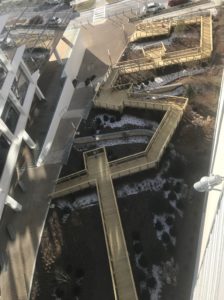
When it comes to preserving Maryland’s diverse and unique ecosystems, incorporating bioretention systems and other green infrastructure is critical. Pollutants and debris from roadways and other surfaces can get swept into nearby wetlands and waterways after heavy rain, and stormwater management systems are a necessary addition to any developed property. Bioretention systems utilize various tools to keep pollutants out of local waterways and mitigate the harmful effects of stormwater runoff. Read on to learn more about the basics of bioretention systems and the different forms of green infrastructure that can help protect the environment in Maryland.
What are Bioretention Systems?
Bioretention systems are landscape features designed to control stormwater runoff, filter pollutants, and reintroduce cleaner water into the nearby water system. Most bioretention systems combine mechanical filtration (pea gravel, stone, and sand) with beneficial native plants to isolate pollutants before they can reach nearby groundwater. Many of these pools, ponds, and gardens become habitats for insects and birds. Bioretention systems are rapidly gaining popularity for their ability to blend visual appeal with environmental conservation.
Types of Green Infrastructure
Bioswales and rain gardens are popular applications for bioretention design concepts, but other kinds of green infrastructure use different approaches to stormwater management. Permeable pavement is another popular solution that combines porous cement or asphalt with an underground reservoir that holds runoff. While many retention ponds contain native plants for filtration, some retention and detention ponds are quite basic and simply act as basins to hold stormwater until it evaporates or is reintroduced slowly into the surrounding environment.
Benefits of Bioretention Systems
Although many bioretention systems are visually appealing, they do much more than provide pretty scenery. Stormwater runoff can cause damage when left unchecked, both to local waterways and manmade structures. Water damage is a serious threat to residential and commercial properties throughout Maryland, and well-designed bioretention systems can help mitigate this threat. Bioretention systems can also provide financial benefits in some cases; many builders pursue LEED Certification for their projects, and green infrastructure can be an asset when seeking certification. LEED Certification can help boost a project’s public image and resale value. Of course, the main benefit of bioretention systems for Maryland properties is that builders, managers, and owners know that they are doing their part to keep the state’s waterways clean.
ABOUT RELIABLE CONTRACTING
Reliable is dedicated to delivering quality products, displaying professionalism within the firm, seeking new opportunities for expansion and profitability, and providing an environment for individual success. If you have a commercial or residential construction project that you need taken care of, please contact Anne Arundel County’s largest site-work contractor today by calling 410-987-0313 or visiting our website. You can also follow Reliable Contracting on Facebook, LinkedIn, Pinterest, and Twitter!
Reliable Contracting Company serves the following and surrounding counties: Annapolis, Queen Anne’s, Anne Arundel, Baltimore, Baltimore City, Calvert, Caroline, Charles, Howard, Prince George, St. Mary’s, Talbot, and Washington D.C.
